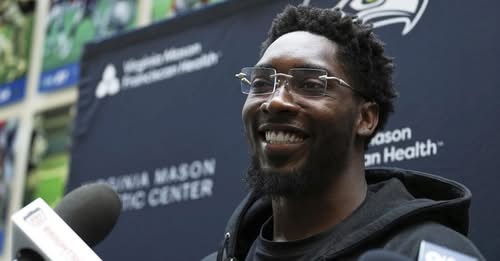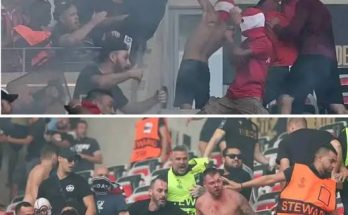After attending Seahawks training camp this week, former NFL quarterback and respected football analyst Brock Huard couldn’t stop raving about one player in particular—four-time Pro Bowl defensive end DeMarcus Lawrence. While much of the conversation in Seattle has centered around new offensive pieces and the development of young talent, Huard’s focus was firmly planted on the veteran defensive lineman, a player who has spent the bulk of his career terrorizing quarterbacks in a Dallas Cowboys uniform. Now donning Seahawks colors, Lawrence has entered a new chapter of his career with renewed vigor, and Huard believes that if his early camp performances are any indication, the 33-year-old could turn out to be one of the most important pieces in Seattle’s 2025 campaign.
DeMarcus Lawrence is no stranger to high expectations. A second-round pick out of Boise State in 2014, Lawrence quickly rose through the ranks to become one of the most dominant edge rushers in the NFL. With 58.5 career sacks, multiple Pro Bowl selections, and a reputation as one of the league’s most consistent run defenders, Lawrence has built a résumé worthy of Hall of Fame discussion. But after over a decade with the Cowboys, the marriage between team and player began to show signs of wear. Injuries mounted. The defense around him fluctuated. And while Lawrence continued to contribute at a high level, there was a growing sense that both sides needed a fresh start. That opportunity came in the form of a surprise signing by the Seattle Seahawks this offseason, who not only sought veteran leadership in their locker room but also needed someone who could stabilize a defensive front that had been wildly inconsistent over the past few seasons.
From the moment Lawrence arrived in Renton, the tone changed. Seahawks coaches and teammates alike noted how immediately impactful he was in walkthroughs, positional drills, and full-team scrimmages. His technique, first step, and relentless motor were all still intact. But what’s more, Lawrence brought with him a sense of professionalism that younger defenders like Boye Mafe and Derick Hall found infectious. Huard, who observed multiple practice sessions, stated that Lawrence wasn’t just going through the motions or “veteran coasting.” Instead, he described Lawrence as “absolutely dialed in,” using every rep to gain a mental edge, schooling young offensive tackles in the process, and offering detailed feedback to up-and-coming defenders on the sideline.
Huard’s most striking comment came when he declared Lawrence had the potential to be “an absolute force and monster” this fall. That statement holds weight coming from someone who not only played in the NFL but has spent years studying film and covering high-level football. He highlighted Lawrence’s explosive get-off at the snap, noting that even at 33, he still has one of the quickest first steps in the league. Perhaps more importantly, he emphasized Lawrence’s improved hand usage—something that’s evolved over the years from raw athleticism into masterful technique. According to Huard, Lawrence has mastered the art of disrupting plays not only by pressuring the quarterback but also by understanding the broader structure of the offensive line’s blocking scheme. It’s not just about beating the man in front of him; it’s about manipulating protections and forcing mistakes.
Lawrence’s arrival in Seattle comes at a critical time for the Seahawks defense. Over the past two seasons, the unit has seen flashes of brilliance but struggled with consistency. In particular, their inability to generate pressure on a regular basis has left the secondary vulnerable. Too often, quarterbacks had clean pockets to exploit mismatches downfield. Bringing in Lawrence changes that equation. While he may not be the 25-year-old sack machine he once was, his presence on the edge forces offenses to account for him on every play. That, in turn, opens up opportunities for others—especially rising talents like Uchenna Nwosu, who has emerged as one of Seattle’s most promising defensive weapons.
But Huard believes Lawrence’s value goes beyond the stat sheet. It’s about leadership, mentorship, and the ability to set a tone in the locker room. With Bobby Wagner no longer in the fold and Jamal Adams fighting to stay on the field, there’s a leadership vacuum on the defensive side of the ball. Lawrence, who captained multiple Cowboys units, has stepped into that role without hesitation. Coaches have spoken openly about how he’s taken the time to break down film with younger teammates, often staying after meetings to go over subtle nuances that aren’t always taught in standard positional sessions. He’s also been instrumental in helping defensive line coach Aaron Curry implement new pass-rush concepts, bridging the gap between theory and execution.
There’s a growing sentiment among those around the Seahawks organization that Lawrence’s addition could be one of the most underrated moves of the offseason. While flashier acquisitions may grab headlines, Lawrence brings something that’s increasingly rare in today’s NFL—sustainable, professional excellence. He understands his body, manages his reps wisely, and brings intensity to each moment. That approach has not only impressed Huard but has also begun to change how the Seahawks defensive front operates on a day-to-day basis. Players are communicating more, stunting and twisting more effectively, and using techniques that show a deeper level of understanding of offensive blocking schemes.
What’s also interesting is how Seattle plans to use Lawrence in defensive coordinator Aden Durde’s evolving scheme. Durde, who was part of the Dallas Cowboys’ coaching staff before joining Seattle, already has a strong relationship with Lawrence and a clear understanding of his skill set. That familiarity could be crucial. Unlike in Dallas, where Lawrence was occasionally pigeonholed into limited roles, Durde appears committed to using him in a variety of ways—lining him up inside on passing downs, occasionally dropping him into coverage to confuse protections, and rotating him between strong and weak side responsibilities. This kind of flexibility plays to Lawrence’s strengths and could extend his effectiveness deep into the season.
Another element Huard pointed out is how Lawrence’s intensity raises the competitive temperature in practice. On multiple occasions, Lawrence reportedly challenged both offensive and defensive teammates, creating an edge that coaches welcome. It’s not confrontational, but it is demanding. He wants the best from everyone around him, and that accountability can be contagious. During a one-on-one drill, he apparently schooled a rookie tackle on back-to-back reps before turning and offering advice on hand placement and weight distribution. That blend of competitiveness and mentorship is hard to find, especially from someone with nothing left to prove.
Of course, questions remain. At 33, can Lawrence stay healthy over the course of a 17-game regular season? Will his body hold up to the physical demands of consistent edge play in a league that’s faster and more explosive than ever before? Huard acknowledged those concerns but pointed to Lawrence’s meticulous offseason preparation, which reportedly included working with high-performance trainers, yoga specialists, and nutrition experts to ensure optimal durability. Moreover, he’s managed to stay relatively injury-free in recent seasons, an encouraging sign for the Seahawks as they gear up for a grueling NFC West schedule.
There’s also the matter of chemistry. Integrating a veteran with a strong personality into a new locker room can sometimes be tricky, but by all accounts, Lawrence has been embraced by his new teammates. Part of that may stem from his willingness to listen as much as he talks. He’s not coming in with a “know-it-all” attitude but rather with the humility of someone who understands that football is a constantly evolving game. He’s learning the language of the Seahawks defense just as much as he’s teaching it, and that mutual respect has created a sense of cohesion that’s been missing in years past.
For Seahawks fans, the hope is that Lawrence can help transform a good defense into a great one. The NFC is stacked with elite quarterbacks—from Jalen Hurts and Brock Purdy to Kirk Cousins and Caleb Williams—and the only way to slow them down is by getting pressure early and often. Lawrence, with his combination of experience, skill, and football IQ, offers a path to doing just that. Even if he doesn’t record double-digit sacks, his impact could be felt in ways that don’t show up on the stat sheet—pressures that lead to hurried throws, tipped passes, blown-up screens, and forced fumbles.
As the Seahawks continue to work through camp and inch closer to preseason action, all eyes will be on how this defense gels, and DeMarcus Lawrence is quickly becoming the centerpiece of that process. If Huard is right—and he often is—then Seahawks fans might soon be watching the resurgence of one of the NFL’s premier defensive linemen. Not as a supporting cast member, but as a lead actor in Seattle’s quest to return to postseason prominence. A force. A monster. And perhaps, the missing piece the Seahawks have been searching for.



